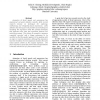Free Online Productivity Tools
i2Speak
i2Symbol
i2OCR
iTex2Img
iWeb2Print
iWeb2Shot
i2Type
iPdf2Split
iPdf2Merge
i2Bopomofo
i2Arabic
i2Style
i2Image
i2PDF
iLatex2Rtf
Sci2ools
PG
2002
IEEE
2002
IEEE
Facial Expression Space Learning
Animation of facial speech and expressions has experienced increased attention recently. Most current research focuses on techniques for capturing, synthesizing, and retargeting facial expressions. Little attention has been paid to the problem of controlling and modifying the expression itself. We present techniques that separate video data into expressive features and underlying content. This allows, for example, a sequence originally recorded with a happy expression to be modified so that the speaker appears to be speaking with an angry or neutral expression. Although the expression has been modified, the new sequences maintain the same visual speech content as the original sequence. The facial expression space that allows these transformations is learned with the aid of a factorization model.
| Added | 15 Jul 2010 |
| Updated | 15 Jul 2010 |
| Type | Conference |
| Year | 2002 |
| Where | PG |
| Authors | Erika Chuang, Hrishi Deshpande, Christoph Bregler |
Comments (0)

